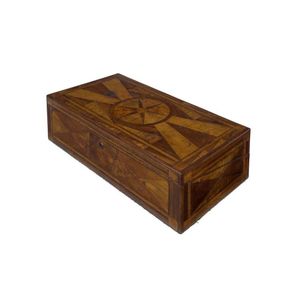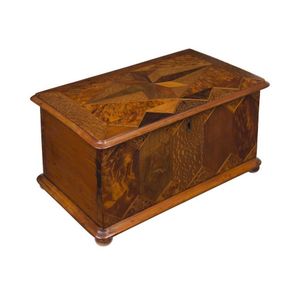Inlaid New Zealand Timber Box, Circa 1890
You must be a subscriber, and be logged in to view price and dealer details.
Subscribe Now to view actual auction price for this item
When you subscribe, you have the option of setting the currency in which to display prices to $Au, $US, $NZ or Stg.
- Circa - A Latin term meaning 'about', often used in the antique trade to give an approximate date for the piece, usually considered to be five years on either side of the circa year. Thus, circa 1900 means the piece was made about 1900, probably between 1895 and 1905. The expression is sometimes abbreviated to c.1900.
- Burr - Burr (or in the USA, burl) is the timber from the knotted roots or deformed branch of the tree, which when cut, displays the small circular knots in various gradations of colour. It is always cut into a decorative veneer, most commonly seen as burr walnut on 19th century furniture.
- Kauri - An evergreen conifer tree associated with New Zealand, but also grown in northern Australia, and islands around the Pacific rim including Borneo, Vanuatu and New Guinea. The timber is generally golden in colour, and straight grained without much knotting.
A by-product of the kauri tree was the kauri gum, the fossilised resin extracted from the tree. The gum was obtained through digging, fossicking in treetops, or more drastically, by bleeding live trees. Kauri gum was used in the manufacture of varnishes and other resin-based products, and also crafted into jewellery, keepsakes, and small decorative items.
Kauri forests were prolific in the north of the North Island of New Zealand. European settlers in the 1700 and 1800s realised that the timber from these tall trees with broad trunks would be ideal for ship building and construction and a thriving industry was established harvesting the kauri tree. The forests were substantially reduced, and now the remaining Kauri trees that grow in New Zealand are protected, and there are reserves in various areas of the North Island.
The remaining stands of kauri in New Zealand are under threat from "kauri disease", a microscopic organism that causes dieback in the trees, with vast tracts either dead or dying.
This item has been included into following indexes:
Visually similar items

A Victorian walnut writing box inlaid with brass and mother of pearl, with original inkwells, interior restored. 14 cm high, 35 cm wide, 24 cm deep

A Tasmanian cedar box decorated with a Tasmanian tiger (thylacine) and applied silver map of Tasmania, 12.5 cm high, 28.5 cm wide, 21 cm deep

A superb Tasmanian timber writing box, huon pine, musk, cedar, blackwood, myrtle, beefwood, honeysuckle and casuarina, cedar secondary timbers, fitted with slope and drawer compartments, circa 1850, 18 cm high, 61 cm wide, 31 cm deep

William Norrie jewel box fitted with two lift out velvet lined trays, New Zealand specimen timbers, two original maker's labels with hand written pencil key on reverse, circa 1890, 16 cm high, 34 cm wide, 20 cm deep
